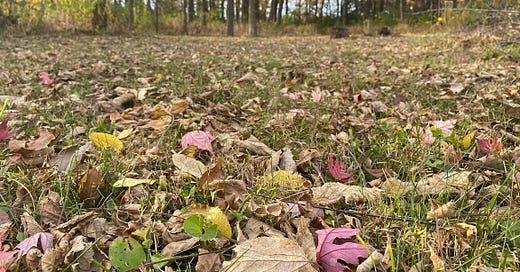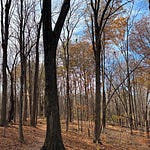This is the newsletter version of Sara by the Season, where I explore a little bit of everything that’s on my mind as I try to lean into nature’s wisdom and rhythms. You can listen to me read you the newsletter by hitting play above - or you can click the little link above and to the right to play in your favorite podcast player. If you know someone who would like this sort of thing, I’d be so grateful if you would share it!
Many wisdom traditions around the world set aside time, and usually around September and October, to celebrate the dead in some form or another: there are the Day of the Dead celebrations in Mexico and many Latin American countries, Hinduism’s Pitru Paksha, Buddhists and Taoists celebrate their ancestors for the entire month of the Hungry Ghost Festival, and the many variations of All Soul’s Day in places where Christianity subsumed the culture’s previous traditions into their own.
In the Celtic tradition, Samhain begins the evening of October 31 and ends the evening of November 1. It is the beginning of the Celtic year and marks the turn toward the darker half of the year. It is said to be a thin space, a time when the ancestors, spirits - and fairies! - are closer than throughout the rest of the year. Most of our American Halloween traditions are adapted from Samhain practices.
At our church, we celebrate All Souls’ Day by bringing in pictures of our loved ones who have died. A few volunteers hang up the pictures all over the place, so that when we walk in on Sunday, the entire room is filled with smiling pictures of our loved ones. Last year, I brought in a picture of my cousin who died when I was 17. He is perpetually 23 in my memory, but he would have celebrated his 50th birthday this year had he lived. I hadn’t talked about him outside of family in years, and our All Souls’ Day celebration was a reminder about the importance of talking about our dead loved ones as a way of honoring and remembering them.
My friend lost her dad this year, and she was telling me about a recent therapy appointment, in which she was sharing with her therapist some frustration that everyone’s lives just seem to go on while it feels to her like everything stalled the day her dad died. The therapist sarcastically responded, “well, yes, it’s been three months since your dad died. That’s about all our culture can handle when it comes to dealing with death. Our culture says you should be moving on by now.” Even though the therapist was right, it made me quite angry and not just for my friend but for how stunted we all must be if we have little to no long-term support to help us carry life’s heavy losses. Barry Spector, in Madness at the Gates of the City: The Myth of American Innocence, writing about the necessity of grief says, “When survivors aren’t allowed sufficient time to grieve, however, the wounds close too soon, remain infected, and never heal.”
Even if you haven’t faced a loved one’s death this year, there are likely other sorts of death that might be in danger of festering and in need grieving: an expectation, a relationship, a story you told yourself that is no longer working for you, your own or your loved ones’ aging, the climate emergency, the state of the world. Living in tune with nature’s rhythms invites us to reflect on what we’re being invited to grieve during this season when nature demonstrates for us the beauty in letting go and the life-giving power of death.
We have watered down the one day of the year that we Americans are even willing to think about death to be consumerized practically to meaninglessness. We desperately need to recover some of our ancestor’s lost rituals and practices that not only help us grieve what needs grieving but also help us relinquish our incessant need to stave off death with our intense workouts and supplements and ten-step skincare routines.
In Francis Weller’s should-be-instant-classic, The Wild Edge of Sorrow, he writes about what’s to come if we don’t:
We are depleting, with an ever-growing tenacity, the complex, multi-layered song of the world and replacing it with a single-pitched monotone, depositing empty calories, sterile seeds, and meaningless objects in every developing country while silencing forever the voices of hundreds of cultures. Every few weeks a language is lost, and, along with it, a nuanced imagination of a people who were rooted to a place for perhaps thousands of years. Soon we will be left with only the barest semblance of the exuberant matrix we once had, as the monoculture of modernity plows into the lives of every culture, replacing their traditions with imitations of our own pale expression of life.
I’ve been walking through some mourning of my own this year and have decided that this fall, the grieving season, that I’m really going to lean into feeling and ritualizing the grief that I need to process as the days grow darker. Martin Shaw, in this prescient essay, writes that “we have to operate from both wonder and grief, at absolutely the same time. One does not cancel the other out, it is the very tension of the love-tangle that makes us, possibly, a true human being.” If Shaw and Weller are right, and I think they are, an integral part of growing and evolving is welcoming in the grief that comes with being a human - and there’s no better time to accept the invitation than autumn when nature offers us extra support with the grief that arises when we’re open to it.
Scattering Seeds
I’m always finding stuff that supports the thesis of the book I’m writing on the benefits of leaning into nature’s wisdom, so I thought I could start sharing those links and things here with all of you in hopes of some of the seeds I share germinating into something beautiful at your place.
Since most of us are so disconnected from communal grief practices, we have to work to recover those we’ve lost or create some of our own. Some ideas of practices that I’ve been collecting for grief season: a grief altar, grief journaling, grief collaging, nature mandalas. If you have a favorite grief season ritual or practice, I’d love to hear about it.
This conversation on “the fall and the underworld” with Martin Shaw would make a wonderful autumn listen.
I can’t get enough of Sophie Strand, and this essay is the perfect read as we celebrate Samhain and Halloween next week. This line, especially, hit me as I’ve been thinking about our fear of death so much lately: “We are the product not of a garden but of an impact. An extinction event. We are the children of the crater. The bodies produced by collision and eruption.”
Here’s to welcoming the grief this season,
Sara














Share this post